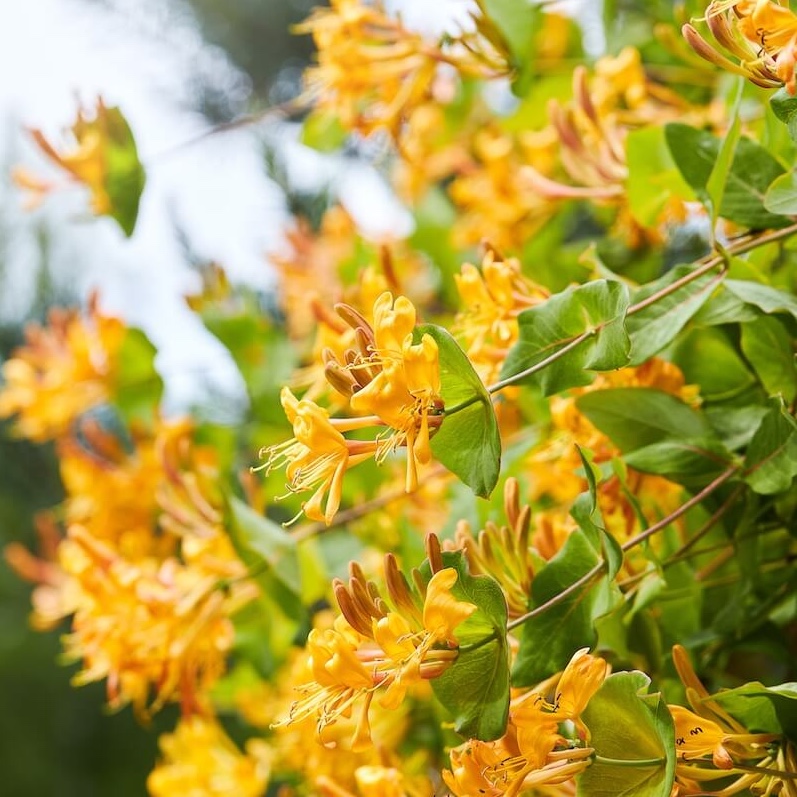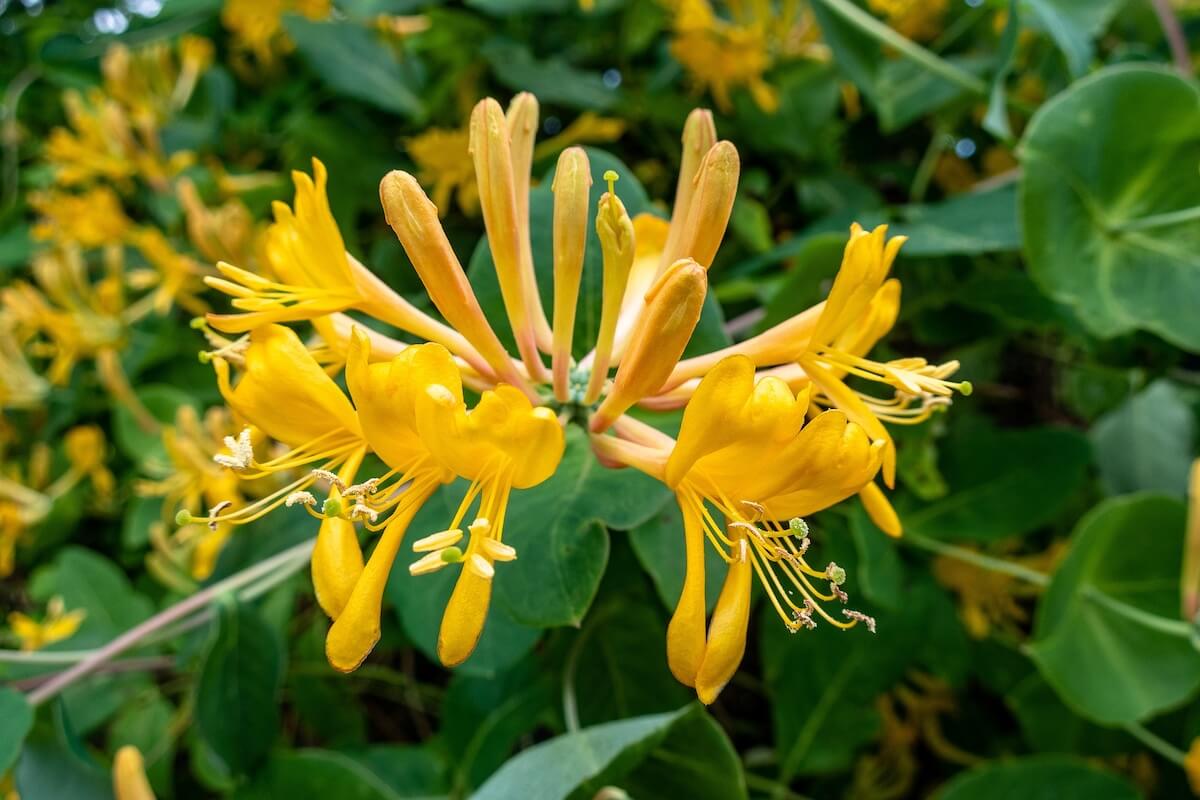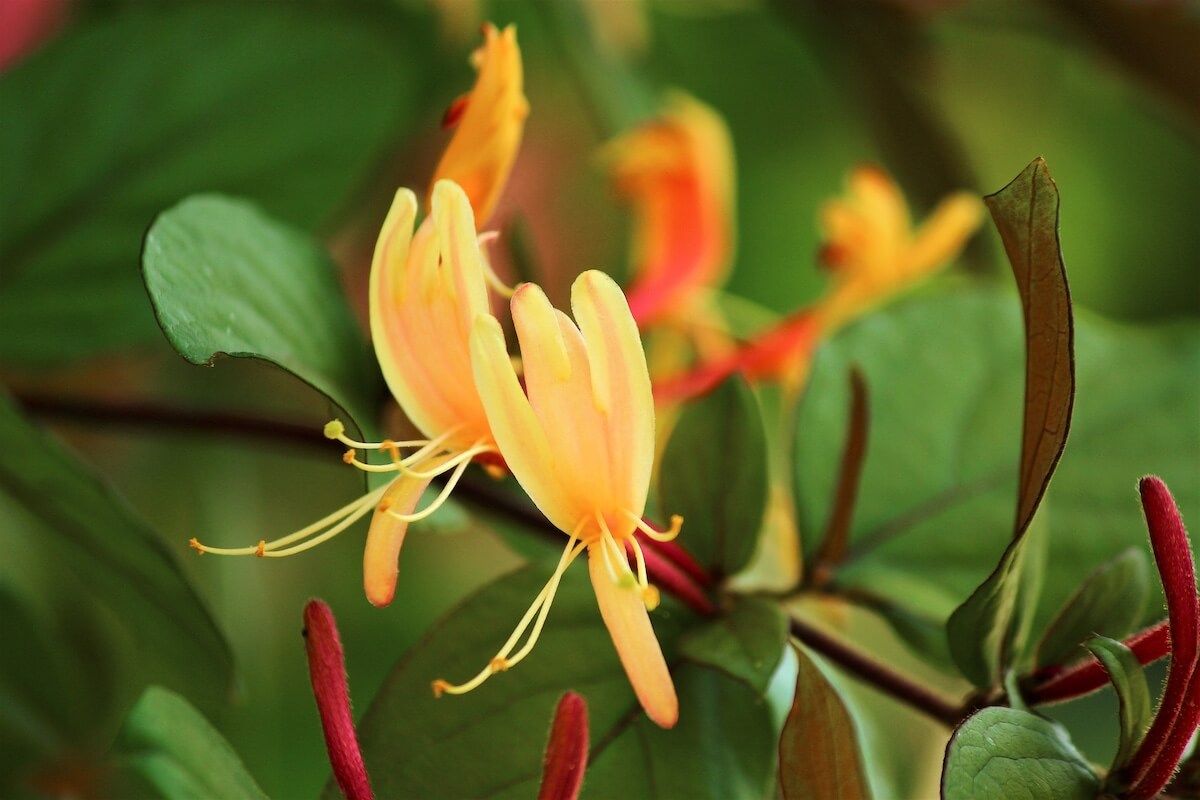
Position
- Prefers full sun or partial shade
- Ideal for a south-west facing position
- Should be sheltered from strong winds
- Roots enjoy cool conditions while the stems reach for sunlight
Hardiness
- Hardy down to -15°C to -10°C (5°F to 14°F)
Soil
- Thrives in moist but well-drained soil
- Suitable for chalk, clay, loam, or sandy soils
- Adaptable to acid, alkaline, or neutral soils
- Grab a soil test kit and ensure the perfect conditions for growth
Height
- Reaches a height of 2.5-4 metres (8-13 feet)
- Takes about 5-10 years to reach its ultimate size
Seasons of Interest
- Flowers in late spring and summer
- Features orange-red flowers, often with a red tint
- Dark green leaves are present, which fall in autumn
- No notable autumn colour display
Additional Notes
- Unscented flowers, which is unusual compared to common honeysuckle
- Excellent for covering walls and fences
- Regular pruning after flowering helps maintain shape; remove about one-third of the flowering shoots
- A layer of mulch in early spring aids moisture retention
- Can be successfully grown in containers
- Recognised for its garden merit
- Fruit is ornamental but not edible
- May require protection from pests like aphids
The Ultimate Guide to Growing Lonicera x tellmanniana: Add Vibrant Colour and Wildlife Appeal to Your Garden
If you want to add a bold burst of colour and wildlife appeal to your outdoor space, Lonicera x tellmanniana—known as Tellmann’s honeysuckle—is an excellent choice. This eye-catching deciduous climber is loved for its stunning orange flowers, which bloom from late spring into early summer. It brings visual impact and offers exceptional value for wildlife, attracting pollinators such as bees and butterflies, while providing late-summer berries for birds.
In this comprehensive guide, we’ll explore everything you need to know about growing Lonicera x tellmanniana successfully—from planting and care to pruning, soil requirements, and design ideas. Whether you’re a beginner gardener or a seasoned enthusiast, this guide will help you make the most of this striking climber.
What Is Lonicera x tellmanniana?
Lonicera x tellmanniana is a vigorous deciduous climbing honeysuckle, best known for its golden-orange tubular flowers and lush green foliage. It’s a hybrid species, bred from a cross between Lonicera sempervirens and Lonicera tragophylla, combining the refined beauty of both parents.
The flowers typically appear in late spring to early summer and can grow up to 5cm long. Unusually for a honeysuckle, these vibrant blooms are unscented, making it an excellent choice if you’re after colour without the heady fragrance often associated with the genus. As a deciduous climber, it sheds its leaves in autumn, providing a bare framework over winter before bursting into life each spring.
Why Choose Lonicera x tellmanniana for Your Garden?
Tellmann’s honeysuckle is an ideal addition to gardens of all sizes. Its vivid floral display brings a fiery splash of colour, contrasting beautifully against green foliage and muted planting schemes. Although the flowers lack scent, their bold colour and nectar-rich structure still make them highly attractive to pollinators, offering great biodiversity benefits.
Lonicera x tellmanniana is perfect for covering fences, arches, trellises, or unsightly garden structures thanks to its fast, upward growth habit. It offers vertical interest, enhances privacy, and softens rigid boundaries with minimal effort. It’s also low-maintenance, making it suitable for gardeners of all experience levels.
How to Plant Lonicera x tellmanniana
Choosing the Best Planting Position
This honeysuckle thrives in a sunny or partially shaded location. Choose a spot with at least 4–6 hours of direct sun each day for the best flower production and vivid colour. A sheltered, south-west facing wall or fence is ideal, providing warmth and protection from harsh winds.
Soil Requirements
Lonicera x tellmanniana prefers fertile, well-drained soil. It can tolerate a range of soil types—including loam, sandy, and clay soils—as long as there’s adequate drainage. Aim for a neutral to slightly alkaline pH (6.0 to 8.0). Before planting, improve poor soils by incorporating organic matter, such as well-rotted manure or compost.

Planting Tips
Dig a hole twice as wide and roughly as deep as the nursery pot. Gently tease out the roots if they’re pot-bound, and place the plant so the rootball is level with the soil surface. Backfill with enriched soil, firm it gently, and water thoroughly. Mulch around the base to conserve moisture and suppress weeds.
If planting near a wall or fence, ensure there’s support in place. Use a trellis, wire framework, or bamboo canes to guide young stems upwards as they establish.
How to Care for Lonicera x tellmanniana
Watering and Feeding
In the first year after planting, water regularly to help the roots establish. Give the plant a deep soak once or twice a week during dry spells. Once established, this honeysuckle becomes moderately drought-tolerant.
If you’ve added organic matter at planting time, there’s usually no need for additional feeding. However, in early spring, you can apply a balanced slow-release fertiliser or mulch with manure to boost the plant for the growing season.
Pruning and Maintenance
Annual pruning helps maintain shape, encourages vigorous flowering, and keeps plants healthy. The best time to prune is immediately after flowering, typically late June to early July. Cut back around one-third of the older stems, removing weak or congested growth to improve airflow and light penetration.
This prevents the plant from becoming woody and leggy and stimulates fresh flowering wood for the following year. As needed, remove any dead or damaged stems throughout the year.
Supporting Your Climber
As Lonicera x tellmanniana matures, its climbing stems will twine naturally, but gentle training is recommended in its early stages. Use garden ties or soft twine to secure the plant to a support structure, guiding it into position and preventing damage from strong winds.
What Type of Soil Is Best for Lonicera x tellmanniana?
Well-drained, moisture-retentive soil is ideal for growing this honeysuckle successfully. It’s adaptable and can grow in heavy clay, loam, or sandy soils, which don’t remain waterlogged. Improving your soil with organic matter will help retain moisture during dry periods and provide vital nutrients.
A neutral to slightly alkaline pH is preferred, although Lonicera x tellmanniana tolerates various soil conditions. If in doubt, a simple soil test kit can help determine your pH before planting.

How to Prune Lonicera x tellmanniana Effectively
Pruning is vital to maintain the plant’s shape, encourage repeat flowering, and prevent it from becoming too dense. Once flowering is finished—usually by early summer—remove one-third of the oldest stems at ground level. Thin out overcrowded shoots to promote airflow and reduce the risk of mildew or pests.
For older, overgrown plants, more significant renovation pruning can be done in late winter, cutting back harder to encourage vigorous regrowth. Always use sharp, clean secateurs and gloves to protect your hands from sap.
Where to Buy Lonicera x tellmanniana
You can purchase Lonicera x tellmanniana from reputable online retailers and specialist plant nurseries like SwiftPlants.com. Choose a well-established plant in a 3-litre pot with healthy, undamaged foliage and a well-developed root system for the best results. Avoid plants showing signs of stress, wilting, or pest issues.
Shopping from trusted suppliers ensures you get a true-to-type variety and a strong start for your new climber.
How to Incorporate Lonicera x tellmanniana into Garden Design
Tellmann’s honeysuckle is wonderfully versatile in the garden. Its upright growth makes it ideal for vertical planting schemes, whether greening a boundary fence, covering a pergola, or adding seasonal colour to a garden arch.
Its warm orange tones pair beautifully with purples, deep blues, or contrasting foliage plants like silver-leaved Artemisia or architectural grasses. In cottage gardens, it blends well with climbing roses or Clematis for a layered, wildlife-friendly look.
Although it lacks the sweet scent of many honeysuckles, its bold flowers still make a visual statement and support pollinators searching for nectar.
Common Pests and Problems
Lonicera x tellmanniana is generally disease-resistant and low maintenance, but it can occasionally face a few issues:
- Aphids may appear in spring and can be controlled with insecticidal soap or a strong jet of water.
- Powdery mildew can affect leaves in dry or overcrowded conditions, so ensure good spacing and airflow.
- Leaf spot or general dieback may occur in poorly drained soils or extreme wet periods—improving drainage usually resolves the issue.
Regular monitoring and good cultural practices will keep your honeysuckle healthy and thriving.
From Darren’s Patch
Tellmann’s honeysuckle has earned its place in my garden thanks to its vibrancy and resilience. While it may lack the sweet scent you’d expect from a honeysuckle, it makes up for its rich, fiery blooms and reliable performance. I grow mine along a sunny fence where it climbs enthusiastically and draws in bees and butterflies every spring. It’s perfect for softening hard lines, and the berries later in the season are a real treat for the birds. I especially appreciate how low-maintenance it is—just a bit of training early on and a light prune after flowering, and it’s good to go. If you’re after a bold splash of colour and a great companion for wildlife, this climber won’t disappoint.
![]()
Key Points to Remember:
- Lonicera x tellmanniana is a vibrant, fragrant climber perfect for adding colour and vertical interest to your garden.
- It prefers full sun or partial shade and well-drained soil with a neutral to slightly alkaline pH.
- Regular pruning after flowering helps maintain shape and encourages new growth.
- The plant attracts pollinators and birds, making it a valuable addition to wildlife-friendly gardens.
- You can buy Lonicera x tellmanniana from nurseries and online retailers, looking for healthy, established plants in 3-litre pots.
With its vibrant colour, wildlife-friendly nature, and easy care requirements, Lonicera x tellmanniana is one of the finest climbing honeysuckles for UK gardens. While its flowers are unscented—unusual for a honeysuckle—this variety more than makes up for its bold colour, robust growth, and a long flowering season.
Whether dressing up a garden wall, creating a natural screen, or adding height to a mixed border, this striking climber offers long-lasting rewards with minimal effort.
Explore our full collection of planting guides for expert advice on climbers and wall shrubs.
Want to learn about other climbers? Read about Boston Ivy here.
Frequently Asked Questions
Q: What is Lonicera × tellmanniana?
A: Lonicera × tellmanniana, commonly known as the honeysuckle climber, is a vigorous, evergreen shrub that produces beautiful clusters of tubular orange flowers, typically blooming in late spring and summer.
Q: How tall does Lonicera × tellmanniana grow?
A: This climbing honeysuckle can reach a height of about 5 metres, making it an excellent choice for covering fences, trellises, or walls.
Q: What type of soil does Lonicera × tellmanniana prefer?
A: It thrives in well-drained soil and can adapt to various soil pH levels, but a slightly acidic to neutral soil is ideal for the best growth.
Q: Does Lonicera × tellmanniana need full sun or partial shade?
A: This honeysuckle loves full sun but can also tolerate partial shade. For the best flowering, plant it in a spot with plenty of sunlight, preferably on a south-west facing wall.
Q: When is the best time to plant Lonicera × tellmanniana?
A: The ideal time to plant this climbing honeysuckle is in the spring or autumn when the weather is mild, allowing the roots to establish before the heat of summer or the chill of winter.
Q: Are the flowers of Lonicera × tellmanniana scented?
A: No, the flowers of Lonicera × tellmanniana have little to no scent, making them an excellent choice for those who prefer a more unscented garden.
Q: How do I care for my Lonicera × tellmanniana?
A: Caring for this shrub involves ensuring well-drained soil, watering it during dry spells, and occasionally pruning to encourage healthy growth and flowering. Adding well-rotted manure in spring can also help boost its vigour.
Q: Can I grow Lonicera × tellmanniana in a pot?
A: Absolutely! You can grow Lonicera × tellmanniana in a pot, ideally a 3-litre or 5-litre pot, but keep in mind it will need regular watering and feeding to thrive in a container.
